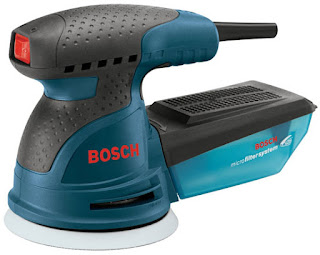So, lets recap so far
1. Multi-head orbital didn't have enough ummph
2. Big boy drum sander with 36 grit, diagonal (sometimes twice) and then straight
3. Edger with 36 grit
But, the trick is, we have to get to 100 grit to put down poly. So, you guessed it, we've got a couple more passes to make. Each room has to have the big boy at 60, then edged at 60, then the big boy at 80, and then edged at 80. But we hate the edger and it was leaving these swirly patterns. So we decided to go with a hand held random orbiter. Now, this is not really a recommended choice anywhere that we found, but we figured it was sort of like the large multi orbital except smaller... so we went with it. Unfortunately, the 60 grit wasn't getting rid of the swirly stuff left by Heath Edger, so we had to go back to 40 grit before going up to 60 grit.
So the pattern went like this
4. Hand held orbital edging with 40 grit
5. Dust the floor - yep, this is what it sounds like. Our book recommended this because when you sand, you not only create wood particles of a certain size, but the sandpaper itself can also shed grit. And if you get a particle the size of 36 grit on your 60 grit paper, well, it'll gouge the crap out of the floor. So, dusting is necessary. We tried a swiffer but the surface was too rough, so we got a pack of microfiber clothes and attached them to the swiffer pole. Worked like a charm :)
6. Big boy with 60 grit
7. Edge with 60 grit
8. Dust the floor
Oh, and then, I almost forgot. We had tons of holes in the floor. Mostly from an old carpet install which meant nail holes around the edges where the tack strips were and staples in the middle of the room where they tacked down the padding. So we spend time after the 60 grit step putting in wood putty in all of the places that needed it so that the 80 grit step would level it down. Ok, back to the steps:
9. Fill with wood putty
10. Big boy with 80
11 Edge with 80
And here's where things get interesting, so I mentioned above that we had to get to 100 grit per the recommendation of the polyurathane, but they don't make 100 grit paper for the drum sander. So for the edges, we're fine, but for the 100 grit... well, our options were limited. A buffer would work, in theory, but after calling around, none of the places that would rent a buffer had 100 grit screens for them, only 120. And some of the literature we read said that poly might not stick properly if the wood was sanded too finely. So we put on our creative pants again and decided to pole sand. Yes, you read that right, we put 100 grit sand paper on a pole sander and went to town. Once we were done with that, the only thing left was cleaning.

No comments:
Post a Comment